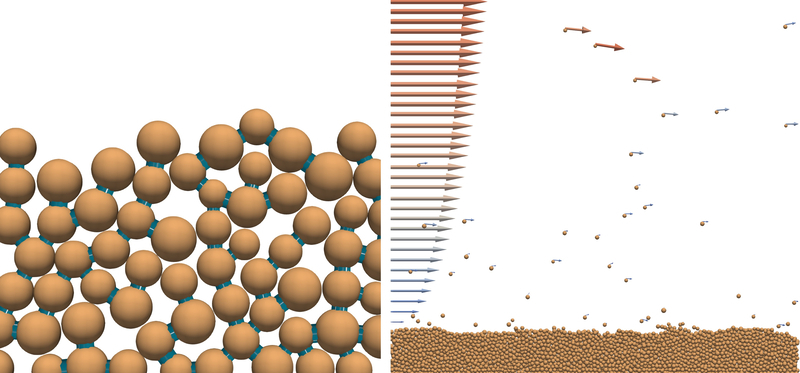X.Wang*, G.H.P. Campmans, T. Weinhart, A.R. Thornton, S. Luding, K.M. Wijnberg
University of Twente
*corresponding author:
Introduction
Worldwide, coastal sandy dunes are bedforms that are essential to protect the land from flooding. They are formed by aeolian processes, in which sediment is transported by wind across the beach. To better understand dune development, it is important to study the dynamic nature of aeolian sediment transport on a small scale. Aeolian sediment transport is not only determined by wind conditions, but also by the properties of the sediment bed. Moisture, as a result of precipitation or tide, is a limiting factor for the erodibility of the sediment bed. This study quantifies the influence of moisture on the two main mechanisms of aeolian sediment transport, i.e., aerodynamic entrainment and the collision process between saltating particles and the bed, on the grain scale.
Methods
Sediment grains and liquid bridges between them are modelled in a discrete element model MercuryDPM (Weinhart et al., 2020). A height-dependent flow profile is applied at the bed boundary to couple the sediment-fluid drag in two directions to force wind-driven sediment transport. In this model, the amount of liquid carried by the particles is determined by the gravimetric moisture content, which allows the modelling of sediment bed with different moisture levels.
Results
In the case of dry sediment transport, the numerical results show a good match with the observations. The existence of moisture increases the threshold for initiating transport, and the bed particles show different behaviours when either initiated by aerodynamics or ejected by saltating particles.

Figure 1: Simulation results in MercuryDPM: left) Sand particles with liquid in between. Right) sand particles being transported by wind (the group of arrows on the left indicates the streamwise wind velocity and the arrows attached to the particles indicate the particle velocities, the larger the size of the arrows, the higher the velocity is).
References
Weinhart, T., Orefice, L., Post, M., van Schrojenstein Lantman, M. P., Denissen, I. F., Tunuguntla, D. R., ... & Thornton, A. R. (2020). Fast, flexible particle simulations—an introduction to MercuryDPM. Computer physics communications, 249, 107129. https://doi.org/10.1016/j.cpc.2019.107129
I. Surname1*, F.N. Another-Surname2 , Y. Next-Surname2
1 University Name, Country; 2 Organization Name, Country
* Corresponding author: mail.name@organization.org


